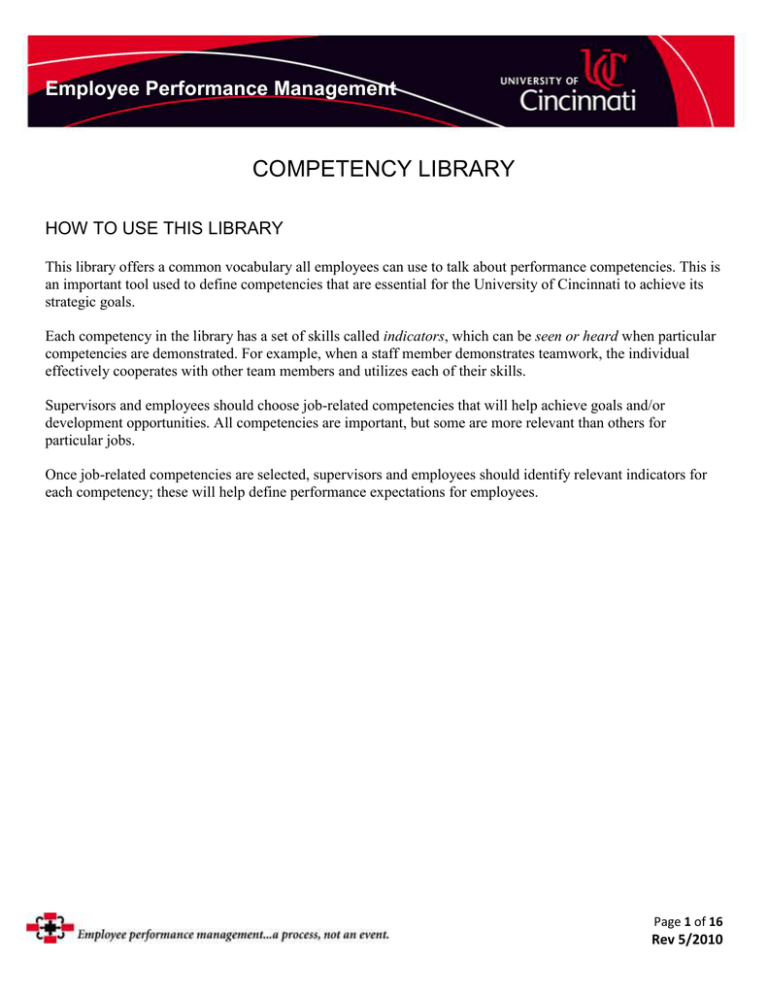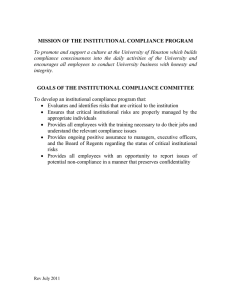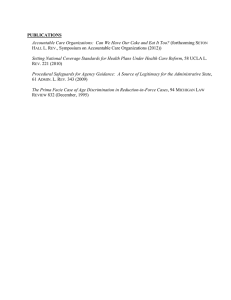Performance Management Competency Library
advertisement

Employee Performance Management COMPETENCY LIBRARY HOW TO USE THIS LIBRARY This library offers a common vocabulary all employees can use to talk about performance competencies. This is an important tool used to define competencies that are essential for the University of Cincinnati to achieve its strategic goals. Each competency in the library has a set of skills called indicators, which can be seen or heard when particular competencies are demonstrated. For example, when a staff member demonstrates teamwork, the individual effectively cooperates with other team members and utilizes each of their skills. Supervisors and employees should choose job-related competencies that will help achieve goals and/or development opportunities. All competencies are important, but some are more relevant than others for particular jobs. Once job-related competencies are selected, supervisors and employees should identify relevant indicators for each competency; these will help define performance expectations for employees. Page 1 of 16 Rev 5/2010 Employee Performance Management TABLE OF CONTENTS I. Organizational Success: How does an employee individually contribute to the overall success of the department? ........................................................................................................................................................ 5 A. Teamwork/Cooperation (within and across units) ....................................................................................... 5 B. Customer Orientation ................................................................................................................................... 5 C. Commitment to Continuous Quality/Process Improvement ........................................................................ 5 D. Creativity/Innovation ................................................................................................................................... 6 E. Flexibility/Adaptability to Change .............................................................................................................. 6 F. Continuous Learning/Development ............................................................................................................. 6 G. Displays Vision ............................................................................................................................................ 8 H. Leadership/Initiative .................................................................................................................................... 8 II. Creating Positive Staff Relations: How does an employee positively interact with others in the workplace?.................................................................................................................................................... 8 A. Respect for Others........................................................................................................................................ 8 B. Interpersonal Skills ...................................................................................................................................... 9 C. Supports Diversity and Understands Related Issues .................................................................................... 9 D. Honesty/Fairness .......................................................................................................................................... 9 E. Builds Trust ................................................................................................................................................ 10 F. Recognizes Others' Achievements/Contributions ...................................................................................... 10 G. Understands Others' Perspectives .............................................................................................................. 10 H. Resolves Conflicts Constructively ............................................................................................................. 10 Page 2 of 16 Rev 5/2010 Employee Performance Management I. Positive Attitude......................................................................................................................................... 11 III. Job Effectiveness: How does an employee maintain a high level of efficiency when approaching his or her responsibilities? .................................................................................................................................... 11 A. Planning/Organization ............................................................................................................................... 11 B. Problem Solving/Judgment ........................................................................................................................ 11 C. Makes Effective Decisions ........................................................................................................................ 12 D. Takes Responsibility .................................................................................................................................. 12 E. Achieves Results ........................................................................................................................................ 13 F. Communicates Effectively ......................................................................................................................... 13 G. Dependability/Attendance.......................................................................................................................... 13 H. Job/Organizational Knowledge .................................................................................................................. 14 I. Attention to Detail...................................................................................................................................... 14 IV. Leadership: How does an employee provide support, encouragement, and leadership to the staff? ......... 14 A. Coaches/Counsels/Evaluates Staff ............................................................................................................. 14 B. Influence Management............................................................................................................................... 15 C. Team Leadership ........................................................................................................................................ 15 D. Change Leadership..................................................................................................................................... 15 E. Enables and Empowers Staff ..................................................................................................................... 16 F. Strives to Achieve Diverse Staff at All Levels .......................................................................................... 16 G. Understands Diversity Issues and Creates Supportive Environment for Diverse Employees ................... 16 Page 3 of 16 Rev 5/2010 Employee Performance Management Page 4 of 16 Rev 5/2010 Employee Performance Management RETURN TO TABLE OF CONTENTS I. Organizational Success: How does an employee individually contribute to the overall success of the department? A. B. C. Teamwork/Cooperation (within and across units) 1. Openly shares information, knowledge and expertise with the team and co-workers; 2. Cooperates with other members to achieve the workgroup's goals; 3. Appropriately gives and is open to feedback from team/coworkers; 4. Puts accomplishing the interests of the University/unit ahead of accomplishing individual goals; 5. Actively works to remove barriers to team effectiveness; 6. Utilizes team members' skills to accomplish goals. Customer Orientation 1. Insists on and/or provides high quality service for internal and external customers; 2. Demonstrates customer focus by seeking out, understanding, and responding to the needs of both internal and external customers; 3. Responds to customers' needs, questions and concerns in an accurate, effective, and timely manner; 4. Develops effective partnerships with customers; 5. Effectively and professionally works with upset customers, solving their problems; 6. Continually seeks efficient ways of providing services by minimizing procedural requirements. Commitment to Continuous Quality/Process Improvement 1. Identifies and implements new processes and initiatives that help the customer/department accomplish its goals; 2. Translates ideas into specific tasks/actions to improve operations; 3. Actively seeks and suggests better ways of getting the job done, and learns from both successes and failures; Page 5 of 16 Rev 5/2010 Employee Performance Management RETURN TO TABLE OF CONTENTS 4. D. E. F. Creatively applies and actively shares expertise and best practices with other departments. Creativity/Innovation 1. Injects originality into daily work through research, personal knowledge, and networking relationships; 2. Thinks "outside the box"; 3. Brainstorms and encourages new ideas and solutions; 4. Takes appropriate risks. Flexibility/Adaptability to Change 1. Displays flexibility and openness in daily work and encourages others to stay open to change, improvements, etc.; 2. Adapts own attitudes and behavior to work effectively with different people and situations; 3. Accepts and readily adapts to changing priorities, better ideas, strategies, procedures, and methods; 4. Maintains work effectiveness in new situations. Continuous Learning/Development 1. Takes the initiative to learn new skills that would benefit the position and operational objectives; 2. Takes ownership of own professional development; 3. Learns from and seeks others' ideas and perspectives; 4. Acts as a mentor and/or encourages other employees to improve and develop individual skills; 5. Seeks feedback on performance; 6. Considers, evaluates, and incorporates others' suggestions about their own performance; 7. Continuously looks for new or nontraditional ideas to improve personal, team and operational effectiveness. Page 6 of 16 Rev 5/2010 Employee Performance Management Page 7 of 16 Rev 5/2010 Employee Performance Management RETURN TO TABLE OF CONTENTS G. H. II. Displays Vision 1. Thinks and considers possible future change; 2. Helps provide a clear customer- focused sense of direction for the team and co-workers to support the department's vision; 3. Develops and/or explains strategic action plans for practical use; 4. Inspires and energizes others to commit to vision; 5. Develops and refines vision to reflect constant and accelerating change impacting UC. Leadership/Initiative 1. Views him/herself as part of the team, not above it; 2. Is flexible and easy to approach; 3. Builds positive working relationships with all staff; 4. Provides recognition; 5. Develops staff; 6. Personally models UC's values, behaviors, and work practices; 7. Has personal credibility and high integrity; 8. Utilizes internal organizational resources effectively; 9. Anticipates and plans for future developments; 10. Tackles difficult problems and decisions, when appropriate; 11. Handles pressure and stress appropriately. Creating Positive Staff Relations: How does an employee positively interact with others in the workplace? A. Respect for Others 1. Treats all people with dignity; 2. Demonstrates compassion, consideration, and caring; Page 8 of 16 Rev 5/2010 Employee Performance Management RETURN TO TABLE OF CONTENTS B. C. D. 3. Believes/assumes the best in others; 4. Demonstrates care for health and safety of others; 5. Values contributions of others; 6. Works to build others' value with positive impact to all; 7. Speaks up on behalf of others when differences are not respected. Interpersonal Skills 1. Attentive to and understands the views of others; 2. Demonstrates an awareness of own style and how it affects others, and makes adjustments as necessary; 3. Resolves interpersonal problems in the workplace; 4. Responds positively to constructive suggestions; 5. Displays objectivity in assessing situations; 6. Develops and maintains positive work relationships with others. Supports Diversity and Understands Related Issues 1. Establishes and maintains effective working relationships with people from diverse backgrounds; 2. Realizes differences in people as opportunities to learn; 3. Contributes to an environment where differences are valued and encouraged. Honesty/Fairness 1. Sets an example by consistently modeling high standards of performance, honesty, and integrity; 2. Is willing to change his/her mind when given new information; 3. Makes sure all ideas receive fair consideration. Page 9 of 16 Rev 5/2010 Employee Performance Management RETURN TO TABLE OF CONTENTS E. F. G. H. Builds Trust 1. Actions support his/her words; 2. Maintains a reputation for honesty, candor, confidentiality, fairness and reliability; 3. Protects the interests of people who aren't present; 4. Judges substance, not image; 5. Offers status reports and keeps others appropriately informed; 6. Follows-up on commitments made in a timely, accurate and complete basis; 7. Makes position clear on difficult issues. Recognizes Others' Achievements/Contributions 1. Promotes systems and processes that encourage and reward the development of people at all levels of the organization; 2. Says "Thank you" and "Great job" on a regular basis; 3. Recognizes and/or rewards others for their contributions and commitment in a manner that corresponds with the employee's values. Understands Others' Perspectives 1. Puts his/herself in "another's position" and demonstrates compassion, consideration, and caring; 2. Understands all points of view with empathy. Resolves Conflicts Constructively 1. Acknowledges personal responsibility in conflict situations; 2. Directly communicates with persons involved in disagreements; 3. Effectively manages conflict between organizational units with the appropriate individuals initially involved; 4. Identifies and constructively addresses disagreements which undermine performance; 5. Encourages people to bring difficult issues into the open; Page 10 of 16 Rev 5/2010 Employee Performance Management RETURN TO TABLE OF CONTENTS I. III. 6. Uses the strength of the facts, rather than the loudness of argument; 7. Resolves differences between people using persuasion, diplomacy and logic; 8. Keeps conflict resolution professional and not personal; 9. Manages conflict with others in ways that preserve good relations; 10. Offers open exploration of differing ideas and solutions within the team. Positive Attitude 1. Creates a "can-do" climate; 2. Approaches others in a pleasant, happy and upbeat manner; 3. Maintains enthusiasm despite criticism of ideas; 4. Demonstrates support to unit/University mission; 5. Demonstrates an "I care" attitude. Job Effectiveness: How does an employee maintain a high level of efficiency when approaching his or her responsibilities? A. B. Planning/Organization 1. Establishes priorities that address the details and timelines needed to achieve the intended results; 2. Focuses on end result; 3. Is flexible and utilizes resources; 4. Updates staff regularly and communicates plans to those involved; 5. Ensures projects are being completed according to plan and reevaluates if necessary. Problem Solving/Judgment 1. Analyzes and solves problems by dealing with facts and not by blaming others; 2. Strikes a balance between being participative, i.e., involving team members in decisions and being directive, depending on the needs of the team and the situation; Page 11 of 16 Rev 5/2010 Employee Performance Management RETURN TO TABLE OF CONTENTS C. D. 3. Seeks involvement from diverse perspectives and areas of the department and/or University to solve problems; 4. Understands the organization and the effect decisions have on other parts of the organization; 5. Proactively anticipates and addresses concerns of employees, peers, upper management, and customers; 6. Formulates alternative/creative solutions to problems; 7. Resolves sensitive issues without making the situation worse; 8. Provides advice and/or information to individuals and teams in a timely manner; 9. Makes timely decisions with quality outcomes. Makes Effective Decisions 1. Gathers information on an issue, impartially considering all sides and makes logical decisions that are clear; 2. Evaluates positive and negative alternatives within time and resource constraints; 3. Uses agreed upon criteria for decision- making rather than hidden agendas; 4. Delegates decision-making responsibility when appropriate; 5. Considers the total organization when making decisions; 6. Keeps the department's long-term goals in mind when addressing short-term issues and problems. Takes Responsibility 1. Follows-through on commitments; 2. Only makes promises that can be kept; 3. Acts like a business owner, taking care of the needs of the unit; 4. Takes responsibility for actions, results, and mistakes; 5. Is willing to accept additional responsibility or authority. Page 12 of 16 Rev 5/2010 Employee Performance Management RETURN TO TABLE OF CONTENTS E. F. G. Achieves Results 1. Gets the job done by doing whatever it takes, within an appropriate time frame; 2. Handles and delivers multiple projects simultaneously; 3. Implements plans and makes mid-course changes when necessary to achieve goals; 4. Sets daily, weekly, monthly, quarterly and annual project goals, creating specific plans to meet them; 5. Shows persistence in overcoming obstacles; 6. Follows through until desired results are achieved Communicates Effectively 1. Communicates in an open, candid and consistent manner; 2. Explains concepts and procedures clearly and completely while maintaining attention and interest; 3. Displays sensitivity to ethnic and gender issues in verbal and written communications; 4. Shows tact and diplomacy in dealing with others; 5. Keeps individuals well informed of key organizational issues and needs; 6. Keeps individuals informed about issues that may affect them; 7. Keeps others informed on the status of assigned work; 8. Delivers information effectively in a variety of settings including one-on-one, team setting, and presentations; 9. Delivers information effectively in a variety of formats including letters, memos, analytical reports, and decision documents. Dependability/Attendance 1. Is available for work on a consistent and timely basis with infrequent unplanned absences; 2. Completes work in a timely manner; Page 13 of 16 Rev 5/2010 Employee Performance Management 3. Meet commitments with minimal oversight; RETURN TO TABLE OF CONTENTS H. I. IV. 4. Meets commitments with others; 5. Conscientious, thorough, accurate, and reliable when performing and completing job tasks. Job/Organizational Knowledge 1. Understands how to get things done in the organization; 2. Possesses knowledge and skills necessary to perform job; 3. Defines resources and actions to achieve objectives within constraints; 4. Builds effective networks and alliances inside and outside the University, which benefit the unit/University. Attention to Detail 1. Double-checks the accuracy of information and work product to provide accurate and consistent work; 2. Provides information on a timely basis and in a usable form to others who need to act on it; 3. Carefully monitors the details and quality of own and others’ work; 4. Expresses concern that things be done right, thoroughly, or precisely; 5. Completes all work according to procedures and standards. Leadership: How does an employee provide support, encouragement, and leadership to the staff? A. Coaches/Counsels/Evaluates Staff 1. Employs a leadership style based on assessing the needs of individuals; 2. Addresses individual needs through coaching and teaching to improve learning and enhance performance; 3. Provides productive feedback to employees, co-workers and upper management in a timely, direct and supportive manner; 4. Coaches others on how to anticipate, define and solve problems; Page 14 of 16 Rev 5/2010 Employee Performance Management 5. Openly shares information and resources; RETURN TO TABLE OF CONTENTS B. C. D. 6. Evaluates performance regularly, accurately and fairly; 7. Monitors staff work and follows- up appropriately; 8. Deals with performance problems directly, fairly, and in a timely manner, providing current, complete and practical positive or corrective feedback. Influence Management 1. Able to make a good/persuasive argument to persuade/influence audience; 2. Develops and uses subtle strategies to influence others; 3. Works to make others feel ownership in one’s own solutions; 4. Identifies key decision- makers on issues of concern; 5. Develops and effectively uses networks, inside and outside the University. Team Leadership 1. Creates a high performance work environment where others pull together to complete tasks; 2. Encourages team members to discover the best ways to perform their jobs effectively; 3. Actively promotes functional as well as cross-functional teams; 4. Empowers teams to achieve goals by providing resources, training, responsibility and authority; 5. Holds teams accountable for performance; 6. Shares successes with team members; 7. Monitors and evaluates team success and difficulty, and provides productive feedback. Change Leadership 1. Helps employees quickly and effectively understand and adjust to new roles, challenges and changes in the University environment and in their jobs; 2. Stays up-to-date on key trends, and opportunities; Page 15 of 16 Rev 5/2010 Employee Performance Management 3. Initiates change instead of reacting to external pressures for change; RETURN TO TABLE OF CONTENTS E. F. G. 4. Makes sure technical/functional decisions are based on department priorities; 5. Uses available resources (people, funds, time, material, support) and coordinates/manages these components, including those outside the organization. Enables and Empowers Staff 1. Provides information and resources so staff can function independently; 2. Enables staff to take appropriate risks; 3. Encourages and promotes decision making and accountability at all levels; 4. Organizes and structures work for others in a manner that encourages ownership and accountability. Strives to Achieve Diverse Staff at All Levels 1. Creates an environment where differences are valued, encouraged and supported; 2. Actively supports individuals for key positions regardless of differences. Understands Diversity Issues and Creates Supportive Environment for Diverse Employees 1. Actively supports the development of others regardless of differences; 2. Respects the talent and unique contributions of every individual, culture and ethnic group to increase effectiveness of the unit; 3. Influences the culture in ways that value and support diversity. Page 16 of 16 Rev 5/2010



